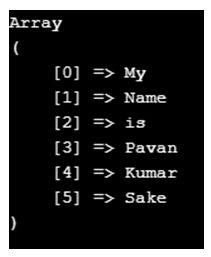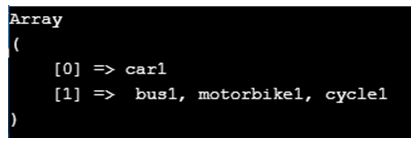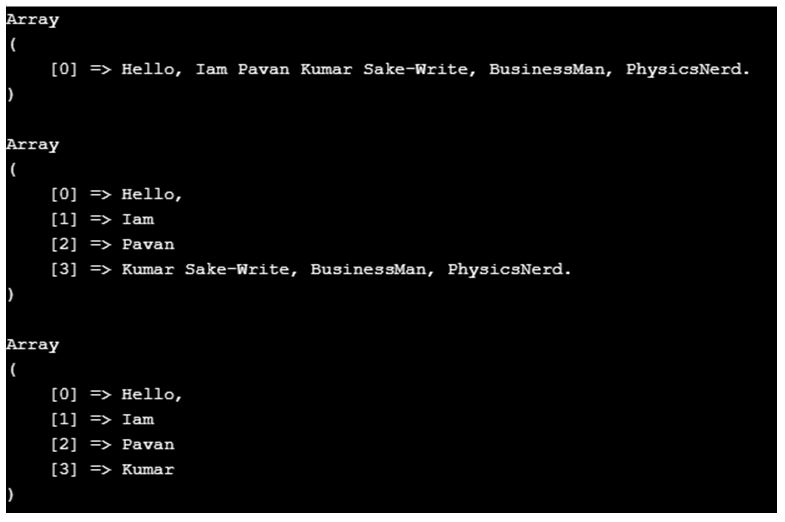PHP explodieren()
The explode() function of the PHP Programming Language is an inbuilt function which helps in splitting a string into many different strings. The explode() function helps splitting the string based on the string’s delimeter which means that it is going to split the string wherever delimeter character will present/occur. This explode() function will return an array which contains the string/string formed after splitting the string which is original. This PHP explode() function usually accepts only three parameters to split a string into many string elements and stores into an array. It is like cutting the big string into many small strings and so on.
Start Your Free Software Development Course
Web development, programming languages, Software testing & others
Syntax:
explode(separator1, OriginalString1, No.ofElements1)
How explode() Function works in PHP?
The explode() function of the PHP Programming Language works based on the three parameters mentioned. They are Separator1, OriginalString1 and No.ofElements1 Parameter. It works by splitting the string into smaller strings with the help of the parameters inside the explode() function. All these smaller string elements are stored in array with index values and also based on the parameters of the explode() function.
Explanation of Parameters:
The Parameters of the explode() function are actually accepting three parameters but in those only two parameters are mandatory and one parameter is an optional parameter.
1. Separator1/Delimeter: The Separator1 Parameter of the PHP Programming Language actually specifies some critical points at which point the string has to split which means that whenever the string character will be found in the string element then it is going to symbolize the end of one array element and start of the another. This delimeter/Separator1 parameter is a mandatory parameter.
2. OriginalString1: The OriginalString1 Parameter of the PHP Programming Language is actually an original string which is used to split a string into many strings and stores in an array only if the string characters are available inside of the string. This OriginalString1 parameter is also a mandatory parameter.
3. No.ofElements1/Limit: This Parameter is an optional parameter and it’s not mandatory. This parameter helps in specifying the number of array elements. This parameter can be of any type of integer.
It can be positive integer, negative integer or the zero integer.
- Positive Integer (N): If No.ofElements1 parameter is passed with Positive Integer value then it means array will contain this number of string elements. If number of elements after separating the elements w.r.t the separator will emerge as to be the value greater then N-1 elements but remains same and the last string element will be the whole remaining string.
- Negative Integer (N): If the negative integer is passed to the No.ofElements1 parameter then last string element N will be trimmed and the remaining array element will be returned as only one single string.
- Zero Integer: If the No.ofElements1 parameter is passed with “Zero” value then the array which is going to return only one string element i.e., Full String (whole string). When no value is passed to this No.ofElements1 parameter then array returned will be going to have total number of elements formed after the string separation with the separator.
Return value Type:
The return value type of the explode() function is the single array with the list of the strings.
Examples of PHP explode()
Given below are the examples mentioned:
Example #1
This is the example of splitting a single string into many small string by taking the space in between the string into the consideration. In the below example inside of the PHP tags, a variable “$s1” is created and assigned a string sentence to the $s1 variable. Then print_r() function is used along with the explode() function in it. Here separator1/delimeter parameter is space “ ”, $s1 is the input parameter/Original String and then here no parameter is mentioned. There is no limit/No.ofElements1 parameter here so there is no limit to splitting of the string. After splitting, inside of the array index values small strings will be stored and printed with the help of the print_r() function.
Syntax:
<?php
$s1 = "My Name is Pavan Kumar Sake";
print_r (explode(" ",$s1));
?>Output:

Example #2
This is the example of implementing with limit value “0”. At first, a variable “$stra” is created and this variable is also assigned with a string value ‘car1, bus1, motorbike1, cycle1’. Then print_r() function is made along with the explode() function in it. In the explode() function, “,” is used as separator1 parameter, $stra variable value is used as OriginalString1 Parameter and value “0” is used as No.ofElements1 Parameter. It is mentioned in the parameters description that if the No.ofElements1/Limit value is mentioned as 0 then the whole original string is considered as one single string array element. This will be printed as shown in the output. Then print function is used to print line break.
Syntax:
<?php
$stra = 'car1, bus1, motorbike1, cycle1';
print_r(explode(',',$stra,0));
?>Output:

Example #3
This is the example of implementing the string splitting with the help of the positive integer as No.ofElements1/limit Parameter. Here at first, a string variable called “$strab” is created with the string value ‘car1, bus1, motorbike1, cycle1’. Then print_r() function is used along with the explode() function along with the three parameters. Here “,” is the Separator1 parameter, “$strab” is the original string element which is nothing but OriginalString1 parameter, “2” is the No.ofElements1/limit Parameter. According to the parameters description, if the positive integer value is passed then n-1 array indexes values will splitted and stored and for N-1 index value, remaining whole string will be printed.
Syntax:
<?php
$strab = 'car1, bus1, motorbike1, cycle1';
print_r(explode(',',$strab,2));
?>Output:

Example #4
This is the program of implementing the string splitting function by using different type of integer values for No.ofElements1/limit parameter. So that one can know what actually happens for different parameters which are acting inside of the explode() function. For the first explode() function, the whole original string is considered as only one array element. Then value “4” is used for the second explode() function. For this, n-1=3 array indexes string values will be printed but for n-1 array index the whole remaining string will be printed. Then for the third explode() function, negative integer value(-N) is used. So at N array index values the string will be trimmed and will be printed starting from the 0 index value.
Syntax:
<?php
$Original_str1 = "Hello, IamPavan Kumar Sake-Write, BusinessMan, PhysicsNerd.";
print_r (explode (" ",$Original_str1, 0));
print "\n";
print_r (explode (" ",$Original_str1, 4));
print "\n";
print_r (explode (" ",$Original_str1, -3));
print "\n";
?>Output:

Das obige ist der detaillierte Inhalt vonPHP explodieren(). Für weitere Informationen folgen Sie bitte anderen verwandten Artikeln auf der PHP chinesischen Website!

Heiße KI -Werkzeuge

Undresser.AI Undress
KI-gestützte App zum Erstellen realistischer Aktfotos

AI Clothes Remover
Online-KI-Tool zum Entfernen von Kleidung aus Fotos.

Undress AI Tool
Ausziehbilder kostenlos

Clothoff.io
KI-Kleiderentferner

Video Face Swap
Tauschen Sie Gesichter in jedem Video mühelos mit unserem völlig kostenlosen KI-Gesichtstausch-Tool aus!

Heißer Artikel

Heiße Werkzeuge

Notepad++7.3.1
Einfach zu bedienender und kostenloser Code-Editor

SublimeText3 chinesische Version
Chinesische Version, sehr einfach zu bedienen

Senden Sie Studio 13.0.1
Leistungsstarke integrierte PHP-Entwicklungsumgebung

Dreamweaver CS6
Visuelle Webentwicklungstools

SublimeText3 Mac-Version
Codebearbeitungssoftware auf Gottesniveau (SublimeText3)

Heiße Themen
 PHP 8.4 Installations- und Upgrade-Anleitung für Ubuntu und Debian
Dec 24, 2024 pm 04:42 PM
PHP 8.4 Installations- und Upgrade-Anleitung für Ubuntu und Debian
Dec 24, 2024 pm 04:42 PM
PHP 8.4 bringt mehrere neue Funktionen, Sicherheitsverbesserungen und Leistungsverbesserungen mit einer beträchtlichen Menge an veralteten und entfernten Funktionen. In dieser Anleitung wird erklärt, wie Sie PHP 8.4 installieren oder auf PHP 8.4 auf Ubuntu, Debian oder deren Derivaten aktualisieren. Obwohl es möglich ist, PHP aus dem Quellcode zu kompilieren, ist die Installation aus einem APT-Repository wie unten erläutert oft schneller und sicherer, da diese Repositorys in Zukunft die neuesten Fehlerbehebungen und Sicherheitsupdates bereitstellen.
 So richten Sie Visual Studio-Code (VS-Code) für die PHP-Entwicklung ein
Dec 20, 2024 am 11:31 AM
So richten Sie Visual Studio-Code (VS-Code) für die PHP-Entwicklung ein
Dec 20, 2024 am 11:31 AM
Visual Studio Code, auch bekannt als VS Code, ist ein kostenloser Quellcode-Editor – oder eine integrierte Entwicklungsumgebung (IDE) –, die für alle gängigen Betriebssysteme verfügbar ist. Mit einer großen Sammlung von Erweiterungen für viele Programmiersprachen kann VS Code c
 Erklären Sie JSON Web Tokens (JWT) und ihren Anwendungsfall in PHP -APIs.
Apr 05, 2025 am 12:04 AM
Erklären Sie JSON Web Tokens (JWT) und ihren Anwendungsfall in PHP -APIs.
Apr 05, 2025 am 12:04 AM
JWT ist ein offener Standard, der auf JSON basiert und zur sicheren Übertragung von Informationen zwischen Parteien verwendet wird, hauptsächlich für die Identitätsauthentifizierung und den Informationsaustausch. 1. JWT besteht aus drei Teilen: Header, Nutzlast und Signatur. 2. Das Arbeitsprinzip von JWT enthält drei Schritte: Generierung von JWT, Überprüfung von JWT und Parsingnayload. 3. Bei Verwendung von JWT zur Authentifizierung in PHP kann JWT generiert und überprüft werden, und die Funktionen und Berechtigungsinformationen der Benutzer können in die erweiterte Verwendung aufgenommen werden. 4. Häufige Fehler sind Signaturüberprüfungsfehler, Token -Ablauf und übergroße Nutzlast. Zu Debugging -Fähigkeiten gehört die Verwendung von Debugging -Tools und Protokollierung. 5. Leistungsoptimierung und Best Practices umfassen die Verwendung geeigneter Signaturalgorithmen, das Einstellen von Gültigkeitsperioden angemessen.
 Wie analysiert und verarbeitet man HTML/XML in PHP?
Feb 07, 2025 am 11:57 AM
Wie analysiert und verarbeitet man HTML/XML in PHP?
Feb 07, 2025 am 11:57 AM
Dieses Tutorial zeigt, wie XML -Dokumente mit PHP effizient verarbeitet werden. XML (Extensible Markup-Sprache) ist eine vielseitige textbasierte Markup-Sprache, die sowohl für die Lesbarkeit des Menschen als auch für die Analyse von Maschinen entwickelt wurde. Es wird üblicherweise für die Datenspeicherung ein verwendet und wird häufig verwendet
 Erklären Sie die späte statische Bindung in PHP (statisch: :).
Apr 03, 2025 am 12:04 AM
Erklären Sie die späte statische Bindung in PHP (statisch: :).
Apr 03, 2025 am 12:04 AM
Statische Bindung (statisch: :) implementiert die späte statische Bindung (LSB) in PHP, sodass das Aufrufen von Klassen in statischen Kontexten anstatt Klassen zu definieren. 1) Der Analyseprozess wird zur Laufzeit durchgeführt.
 PHP -Programm zum Zählen von Vokalen in einer Zeichenfolge
Feb 07, 2025 pm 12:12 PM
PHP -Programm zum Zählen von Vokalen in einer Zeichenfolge
Feb 07, 2025 pm 12:12 PM
Eine Zeichenfolge ist eine Folge von Zeichen, einschließlich Buchstaben, Zahlen und Symbolen. In diesem Tutorial wird lernen, wie Sie die Anzahl der Vokale in einer bestimmten Zeichenfolge in PHP unter Verwendung verschiedener Methoden berechnen. Die Vokale auf Englisch sind a, e, i, o, u und sie können Großbuchstaben oder Kleinbuchstaben sein. Was ist ein Vokal? Vokale sind alphabetische Zeichen, die eine spezifische Aussprache darstellen. Es gibt fünf Vokale in Englisch, einschließlich Großbuchstaben und Kleinbuchstaben: a, e, ich, o, u Beispiel 1 Eingabe: String = "TutorialPoint" Ausgabe: 6 erklären Die Vokale in der String "TutorialPoint" sind u, o, i, a, o, ich. Insgesamt gibt es 6 Yuan
 Was sind PHP Magic -Methoden (__construct, __Destruct, __call, __get, __set usw.) und geben Sie Anwendungsfälle an?
Apr 03, 2025 am 12:03 AM
Was sind PHP Magic -Methoden (__construct, __Destruct, __call, __get, __set usw.) und geben Sie Anwendungsfälle an?
Apr 03, 2025 am 12:03 AM
Was sind die magischen Methoden von PHP? Zu den magischen Methoden von PHP gehören: 1. \ _ \ _ Konstrukt, verwendet, um Objekte zu initialisieren; 2. \ _ \ _ Destruct, verwendet zur Reinigung von Ressourcen; 3. \ _ \ _ Call, behandeln Sie nicht existierende Methodenaufrufe; 4. \ _ \ _ GET, Implementieren Sie den dynamischen Attributzugriff; 5. \ _ \ _ Setzen Sie dynamische Attributeinstellungen. Diese Methoden werden in bestimmten Situationen automatisch aufgerufen, wodurch die Code -Flexibilität und -Effizienz verbessert werden.
 PHP und Python: Vergleich von zwei beliebten Programmiersprachen
Apr 14, 2025 am 12:13 AM
PHP und Python: Vergleich von zwei beliebten Programmiersprachen
Apr 14, 2025 am 12:13 AM
PHP und Python haben jeweils ihre eigenen Vorteile und wählen nach den Projektanforderungen. 1.PHP ist für die Webentwicklung geeignet, insbesondere für die schnelle Entwicklung und Wartung von Websites. 2. Python eignet sich für Datenwissenschaft, maschinelles Lernen und künstliche Intelligenz mit prägnanter Syntax und für Anfänger.






